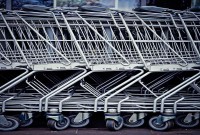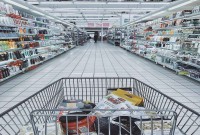- Home
- Business Processes
- Industry Knowledge
- Aerospace Industry
- Automotive Industry
- Banking Domain
- BFSI Industry
- Consumer/ FMCG Industry
- Chemicals Industry
- Engineering & Construction
- Energy Industry
- Education Domain
- Finance Domain
- Hospitality Domain
- Healthcare Industry
- Insurance Domain
- Retail Industry
- Travel and Tourism Domain
- Telecom Industry
- Leadership Skills
- eLearning
- Home
- Industry Knowledge
- Retail Industry
- Retail Industry: Value Chain
Retail Industry: Value Chain
The retail value chain defines a series of actions that enable businesses to sell their products to customers. Value Chain for any industry describes how an industry is structured and its methods for maximizing revenues. Learn the value chain of the industry. Learn about the key partners, key activities, cost structures, and revenue streams of the retail sector. The value/supply chain analysis reveals the business activities which comprise the movement of retail goods.
Value Chain for any industry describes how an industry is structured and its methods for maximizing revenues and profits. The value chain is independent of competitors and the current state of the market, which is where business strategy comes in. The business strategy describes how the company will engage competitors, identify and segment customers, and respond to the actual market environment.
Key Activities in the Retail Industry:
Retailers spend significant time and effort shaping the shopping experience (through store layouts and/or website design) and finding opportunities to increase the share of sales and overall order size. Marketing efforts are focused on point-of-sale, up-selling, and cross-selling, encouraging customers to purchase more than what they originally began shopping for.
The key for the traditional retailer is determining the correct merchandising mix, offering exactly the right products in the right sizes and colors, along with complementary products. Finally, retailers are now focusing on purchase and customer analytics to better understand buying habits and tastes.
Manage the cost and ultimate price to customers; focus on problem-solving for the customer, providing a useful service that meets the need at a fair price. In this article, we will discuss the building blocks for the value chain of the Retail Industry. The retail value chain is split into two distinctive components: the buy-side of the chain, and the sell-side of the chain.
1. Buy-Side of Retail Value Chain:
The buy-side of the value chain involves the retailer sourcing products from suppliers and incurring costs on infrastructure and getting ready to sell. Retailers are very familiar with the buy-side of the chain, which is made up of the functions that support the interaction between a retailer and its suppliers.
Because of low margins, traditional retailers are much cost-driven. They attempt to create economies of scale to overcome significant fixed costs associated with a large retail footprint. The digital retailer flips much of this upside-down with relatively low fixed costs and the ability to grow sales without significantly increasing costs. Premium retailers are more value-driven than cost-driven.
The cost structure ties in closely to the value proposition since customers must feel they are receiving more than they are paying, or at least the potential to take advantage of the company if they make full use of its services. Cost structures include the activities of warehouse management, inventory management, and product and vendor analytics.
Key Partners – Supply/Buy Side:
Key partners for the retail industry include major brand manufacturers, regional and national suppliers, and local governments. To appeal to a wide variety of consumer tastes, traditional retailers must have access to national name brands and plenty of products. Local governments can strongly influence the choice of retail locations as well as provide tax incentives.
The buy-side is composed of the following functions:
Warehouse Management:
Warehouse management and distribution logistics involve the physical warehouse where products are stored after they have been procured. This function also encompasses the activities of the receipt and movement of goods. The finished goods normally go to either a temporary storage location, the retail store, or to the final customer.
Inventory Management:
Inventory management involves maintaining a certain level of goods and merchandise on hand at all times. This can help protect against delays and ensure that customer sales can continue, even if unexpected problems arise. Making available the right product to the customer with the right carrying costs is the objective. If inventory management is not proper the retailer could end up storing high value or slow-moving goods in the inventory.
Product and Vendor Analytics:
Retailers today focus on optimizing supply chain operations and managing real estate. Product and vendor analytics involves analyzing sales patterns, inventory levels, and vendor performance to ensure deliveries are accurate and products are profitable. Retailers must find reliable vendors, while also keeping costs low enough to make a profit. The retail industry relies heavily on human resources and physical infrastructure.
2. The Sell-Side of the Chain:
The sell-side involves the retailer marketing and selling these products to customers. The traditional retail business model emphasizes convenience as the value proposition. Beyond that, each variation offers a different value proposition: price for the low-cost retailer, value and quality for the cost plus retailer, and quality and prestige for the premium retailer. The sell-side of the chain encompasses the functions that support the interaction between a retailer and its customers. Sometimes called customer chain management, the sell-side entails retailers proactively anticipating, meeting, and managing the needs of their customers before the onset of a demand. The sell-side of the chain consists of the following functions:
Sales Channels:
Customer point-of-interaction entails interacting with the customer through various channels, which can be online or offline. The traditional retailer sells through two main channels: bricks-and-mortar retail stores and their own company websites. Sometimes these retailers work with other mass merchants to distribute their own branded products.
Sales Operations:
Sales operations involve any functions that directly promote, support, or sell a product or service. Most traditional retailers target the mass market, but some choose to target specific segments, such as consumer electronics, home goods, and office supplies. Premium retailers always target specific segments within the mass market, although they often build brands that appeal to the mass market. The largest source of revenue for the traditional retailer is from profit on the sale of products or services. Some retailers also collect rebates and incentives from manufacturers in return for premium shelf space (or website placement) and promotion.
Customer Relationships & Sale Analytics:
Customer and sale analytics involves collecting and analyzing information about customers, their concerns, and their needs. This knowledge can give a retailer a complete picture of the market. For traditional retailer, customer relationships depend on the style of the retailer. The low cost and cost-plus retailer generally focuses on self-service or pre-sale service, while the premium retailer emphasizes personal assistance and post-sale service. Digital retailers focus almost exclusively on self-service.
Related Links
You May Also Like
-
Retail Industry: Strategies for overcoming challenges
To stay competitive in this ever-evolving landscape, it is imperative for retailers to deliver a seamless customer experience and provide the right services and products at the right time. Learn the strategies for overcoming challenges for the retail industry. Retailers must use technology and solutions to revive their businesses in the COVID-19 world. An omnichannel marketing strategy can help retailers reach a wider audience for their brands.
-
Retail Industry: Revenue Model
Understand the traditional retail revenue model and, what are the variations in different revenue models adopted by key players in the retail industry. Analyze the pros and cons of various models. The most common and most profitable revenue model is that of the traditional retailer. The traditional retailer profits by selling products and services directly to buyers at a mark-up from the actual cost.
-
Business Dynamics of Consumer Industry
The consumer goods industry is impacted by many dynamics like economic considerations, product considerations, price considerations that impact consumer buying choices. Advertisements, branding, marketing, variety of goods, and technology are the main drivers. Manufactures, retailers, warehousing, and logistics are all part of the supply chain for the consumer goods industry.
-
Durable goods are consumer goods that have a long life span (e.g. 3+ years) and are used over time. Highly durable goods such as refrigerators, cars, or mobile phones usually continue to be useful for three or more years of use, and hence durable goods are typically characterized by long periods between successive purchases.
-
Retail Industry – Drivers & Dynamics
To succeed in the retail sector, retailers must offer compelling value propositions and be responsive to market dynamics. The continued rise of e-commerce has altered the dynamics of the retail industry in such a way that has forced retailers to drastically reallocate their resources to multi-channel strategies. This article focuses on retail industry drivers and dynamics that provide the reader with a basic understanding of the factors that influence this trade. Understand the business drivers and dynamics of retail industry
-
Retail Industry - Business Model
A retail business model articulates how a retailer creates value for its customers and appropriates value from the markets. In retail, a business model would dictate the product and/or services offered by the retailer, the pricing policy that he adopts. Many different types of retail establishments exist, and, the overall industry has seen a significant blurring of the boundaries that separated the wide range of retail businesses. Understand the key business models adopted by the retail industry. Understand the distinctive ways that retail industry players use to reach to the end consumer.
-
Markets are continuously changing and to understand the dynamics of any industry it is important to understand what is happening and how the industry market players see the future for the industry. In this article, we will discuss the recent trends witnessed by the retail sector. This document provides insights into major trends identified for the retail sector.
-
FMCG or consumer packaged goods (CPG) are products that are sold quickly and at relatively low cost, examples include non-durable goods such as soft drinks, toiletries, and grocery items. They generally sell in large quantities, so the cumulative profit on such products can be substantial and these industries often operate on thin margins.
-
Retail Industry: Key Performance Metrics
You cannot manage what you do not measure and cannot measure what you do not define. Learn the key performance metrics for the retail industry like Sales per square foot, Gross margins return on investment, Average transaction value, Customer retention, Conversion rate, Foot traffic, and digital traffic and Inventory turnover, etc. These metrics are used across the globe by key industry players to track and improve their performance.
-
From an economic standpoint, there are three main types of consumer goods: durable goods, nondurable goods, and services. For marketing purposes, consumer goods can be grouped into different categories based on consumer behavior, how consumers shop for them, and how frequently consumers shop for them. One of the largest consumer goods groups is called fast-moving consumer goods. This segment includes nondurable goods like food and drinks that move rapidly through the chain from producers to distributors and retailers than on to consumers.
Explore Our Free Training Articles or
Sign Up to Start With Our eLearning Courses

About Us
Learning
© 2023 TechnoFunc, All Rights Reserved










